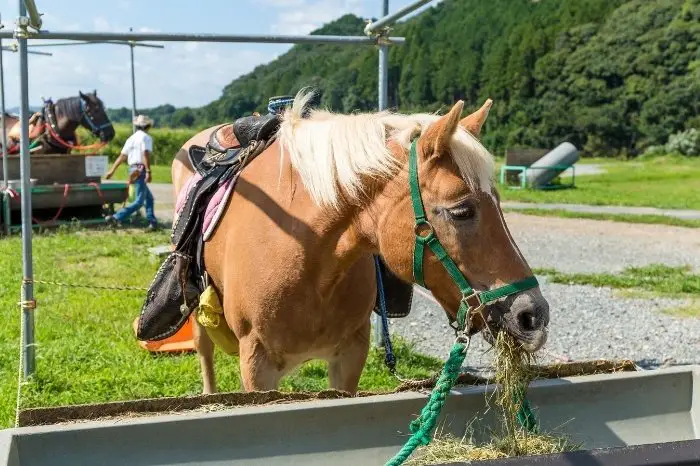Last Updated on July 31, 2020
What can a few tiny blister beetles do to your 1000-pound horse? More damage than you would think. When it comes to blister beetles (Epicauta), even just a few grams of these insects can be lethal to a horse. Blister beetles contain a chemical called cantharidin, which is toxic to cattle, sheep, and especially horses.
Cantharidin is used as a self-defense mechanism for the beetles and is a vesicant, meaning it causes blister formations.
Blister Beetles in Alfalfa
As grazing herbivores, all horses inadvertently consume insects from time to time. However, alfalfa poses the highest risk for blister beetles due to the beetles swarming the fields when feeding on the flowers. This results in beetles accidentally getting caught in the baling process.

They are typically .5″-1.5″ in length, but may be dried out or in pieces when found in hay. Regardless, the cantharidin can be found throughout any part of the beetle, and remains toxic to animals, even months after the beetles die. Due to the activity level of blister beetles, the highest risk cutting-stage of alfalfa is in mid-summer months.
What Blister Beetles Do To Horses? Effects of Consumption
According to Dr. Espy (DVM), it can take as little as four to six grams of blister beetles to prove fatal to an 1100-pound horse. Symptoms can be wide-ranging depending on the horse’s condition and amount of cantharidin released.
As a result of consumption, affected tissues may range from the mouth, gastrointestinal system, kidneys, and even the heart. Certain regions are prone to different species of blister beetles, some more toxic than others.
In milder cases, there will likely be general inflammation and ulceration in exposed areas, such as the mouth, stomach, and digestive tract. Even in just a few hours, horses may show signs of lethargy, colic, and decreased appetite. Some clinical signs may also include endotoxemia, salivation due to blisters, cardiac arrhythmias, synchronous diaphragmatic flutter (or “thumps”), dehydration, and bloody urine or stool.
Symptoms vary and may be difficult to diagnose without knowledge of the beetles’ presence. And of course, in worst-case scenarios, a horse may die from the toxin.
Treatment and Prevention
Unfortunately, there is no cure for cantharidin toxicity. Although your veterinarian may provide supportive care in mild cases, no antidote exists.

Some owners, particularly in high-risk regions, opt-out of feeding alfalfa entirely despite the rich protein and nutritional content. Experts will advise communication with your hay source, and purchasing hay from the first or late cuttings. Consumers are encouraged to ask farmers at what percentage bloom they harvest (under 20% is the safest). Like all hay, visual inspection is encouraged even though blister beetles may be as small as 1 cm.
Conclusion
Although there is a no “cure” for cantharidin exposure, there are steps you can take to ensure your horses and livestock are safe from the toxic effects of the blister beetle. If you have concerns over blister beetles, your vet and local agriculture extension office are excellent resources. Find this article helpful? Be sure to share!
Equestrian, Marine Corps vet, and Morgan horse enthusiast.

